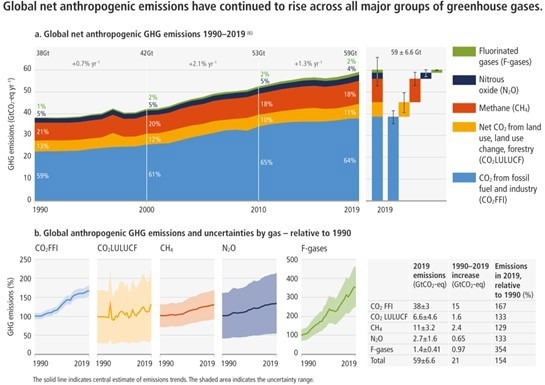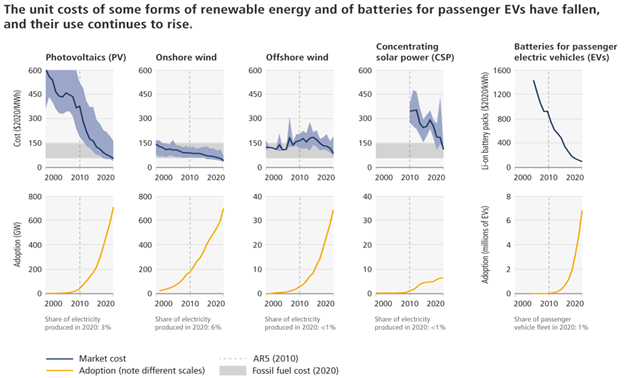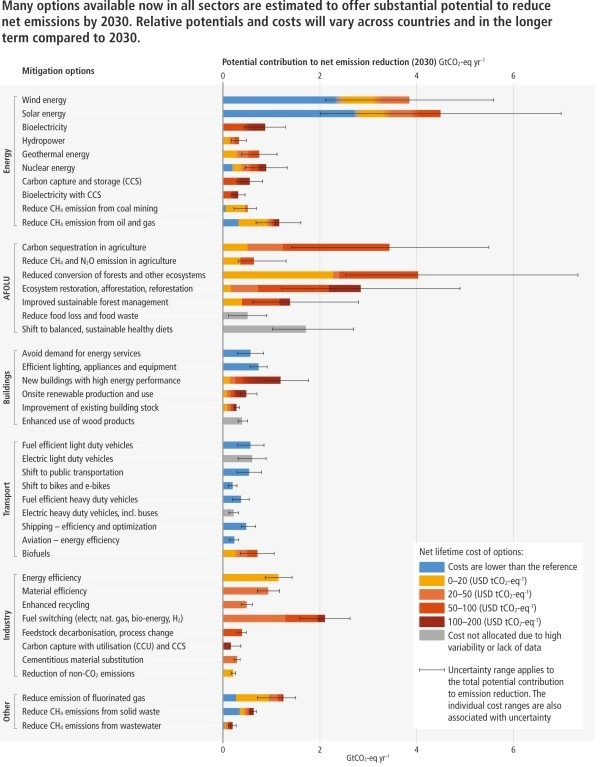The 2022 Intergovernmental Panel on Climate Change (IPCC) report provides an up-to-date global evaluation of climate change mitigation progress and commitments and an examination of the global emissions sources. It analyzes the influence of national climate commitments on long-term emission targets and discusses developments in mitigation and emission reduction activities. This article will summarize the report and its findings.

Image Credit: Denis Burdin/Shutterstock.com
Introduction and Framing
The report incorporates new research findings and expands on earlier IPCC reports, including United Nations (UN) assessments. The following are some of the major developments of the report:
An Evolving International Landscape
The report takes into account developments in the UNFCCC process, such as:
- The implementation of the Paris Agreement and Kyoto Protocol
- The United Nations 2030 Agenda for Sustainable Development, which includes the Sustainable Development Goals (SDGs)
- The changing roles of finance, innovation, and international cooperation
Diverse Actors and Mitigation Approaches
Subnational and non-state actors, including businesses, cities, citizens, public-private enterprises, and transnational initiatives, are increasingly playing a part in the global fight to combat climate change. Global climate policies and low-emission technology cost declines are documented in this report.
The report also addresses the impacts of the COVID-19 pandemic, the varying degrees and types of mitigation measures, and persistent reductions in carbon emissions worldwide.
The Link Between Adaptation, Mitigation and Development
A country's economic growth trajectory has an impact on greenhouse gas (GHG) emissions, and controlling emissions can be difficult and expensive depending on the reduction strategies.
Climate change mitigation measures to eradicate poverty and promote equity and long-term sustainability may be more widely accepted, long-lasting, and effective.
New Approaches in the Assessment
The report includes chapters on demand for services, social dimensions of mitigation, innovation, and technological development for the first time in a Working Group (WG) III report.
It evaluates future paths for 2030, 2050, and 2100, combining an evaluation of the existing pledges and activities with carbon reductions and their consequences for long-term outcomes up to the year 2100.
The Increasing Diversity of Analytical Frameworks
The report presents different analytic frameworks for evaluating the barriers, drivers, and alternatives for mitigation action. These include equality, economic efficiency, social change processes, and socio-political frameworks. They help to identify dangers and opportunities for action, such as equitable transitions at local, national, and international levels.
Recent Developments and Current Trends in Anthropogenic Greenhouse Gas Emissions
The report states that there has been an increase in total anthropogenic GHG emissions since 2010.
Despite a slower pace of development than the decade preceding it, annual average GHG emissions from 2010 to 2019 were higher than in any previous decade.

Global net anthropogenic GHG emissions 1990–2019. Image Credit: IPCC (2022, fig. SPM.1, p. 6)
GHG emissions are influenced by regional differences. Regional and national emissions per capita vary significantly at the same income level, and this variation is partly due to the different stages of development in each region.
In terms of household greenhouse gas emissions, the 10% of households with the greatest emissions per capita are responsible for the majority of the household emissions.
Since 2010, the cost per unit of numerous low-emission technology has decreased. Innovation policies have enabled these reduced costs and boosted worldwide adoption. Both targeted and comprehensive innovation policies have helped overcome global low-emission technology's distributional, environmental, and social implications.

Unit cost reductions and use in some rapidly changing mitigation technologies. Image Credit: IPCC (2022, fig. SPM.3, p. 13)
In developing countries, innovation has been delayed because of weaker enabling conditions. Digitalization can reduce emissions in these areas, but it also has the potential to have negative consequences if it is not properly regulated.
Since assessment report (AR) 5, the number of programs and regulations to mitigate climate change has steadily increased. As a result, emissions that would have been produced were avoided, and more capital was allocated to low-GHG technologies and infrastructure. Climate financing flows are dispersed unequally among regions and sectors, making it difficult to see progress toward the Paris Agreement's targets.
In the 21st century, global GHG emissions associated with Nationally Determined Contributions (NDCs) will certainly cause global warming to exceed 1.5 °C. To keep global warming below 2 °C after 2030, a major increase in mitigation strategies is expected.
Without further abatement, cumulative future CO2 emissions from planned and existing fossil fuel infrastructure will exceed cumulative net CO2 emissions, which will cause the warming to exceed 1.5 °C.
System Transformations to Limit Global Warming
In pathways that limit global warming to 1.5 °C (>50 percent), overshoot is restricted, whereas, in pathways that limit warming to 2 °C (>67 percent), rapid action is assumed. Without strengthening post-2020 measures, GHG emissions are anticipated to increase beyond 2025, resulting in a worldwide average temperature increase of 3.2 °C by 2100.
In modeled pathways, global net-zero is reached by 2050, with warming confined to 1.5 °C with low overshoot, and 2 °C by 2070. Achieving and maintaining net-zero globally results in a steady decline in warming. Reduced GHG emissions, particularly methane emissions, by 2030 and 2040 will reduce peak warming.
Modeled pathways for limiting global warming to 1.5 °C with little overshoot call for fast, profound reductions in GHG emissions across all sectors, including a shift from fossil fuels. To accomplish these reductions, modeled mitigation solutions include using low-carbon energy sources such as fossil fuels with carbon capture and storage (CCS) or renewable energy and carbon dioxide removal (CDR) methods to offset residual greenhouse gas emissions.
It is difficult, but not impossible, for the industrial sector to achieve net-zero. Adopting innovative manufacturing methods using hydrogen fuel, low-carbon electricity, and carbon management will allow the industry to progress towards net-zero GHG emissions.
Using low-emission development approaches to achieve net-zero emissions in infrastructures can significantly improve resource efficiency and reduce emissions in metropolitan areas.
For established and developing cities, ambitious mitigation initiatives will involve decreasing or changing energy and material consumption, electrification, reduction in administrative supply chain emissions, and implementation of carbon storage technology.
Buildings, both new and old, can achieve net-zero GHG emissions in 2050 if retrofitted with energy efficiency and renewable sources as part of comprehensive policy packages. Some policies put buildings at risk of becoming carbon-locked for decades, whereas well-designed and well-executed mitigation initiatives have the potential to contribute significantly to the achievement of the Sustainable Development Goals.
Low-GHG emissions technology and demand-side options can help countries reduce transportation-related emissions. It is possible to reduce the demand for all modes of transportation and facilitate the transition to more environmentally-friendly modes through demand-focused interventions.
On a life-cycle basis, electric cars driven by low-emissions energy have the greatest promise for decarbonizing land-based transportation. Ships, aircraft and large land vehicles can all reduce their CO2 emissions by using renewable and low-emission fuels such as sustainable biofuels and low-emission hydrogen fuel.
Agriculture, Forestry and Other Land Use (AFOLU) mitigation strategies can reduce GHG emissions and increase removals when adopted sustainably. Climate change, conflicting land demands, food security, and livelihood conflicts may cause implementation barriers and trade-offs.
Mitigation strategies costing less than $100 tCO2-eq-1 might cut global GHG emissions by half by 2030. Global GDP grows in modeled routes, but without considering the economic advantages of mitigation action from prevented climate change damages. In most of the reviewed research, the global economic benefit of keeping warming to 2 °C can outweigh the cost of mitigation.

Overview of mitigation options and their estimated ranges of costs and potentials in 2030. Image Credit: IPCC (2022, fig. SPM.7, p. 50)
Linkages Between Mitigation, Adaptation, and Sustainable Development
Sustainable development relies on equitable and accelerated climate action in adapting to and mitigating the effects of climate change. Climate change measures might potentially result in trade-offs, which can be addressed by policy design.
The UN 2030 Agenda's Sustainable Development Goals can be used to evaluate climate action from the perspective of sustainable development.
Sustainable development, vulnerability, and climate threats are interconnected. In developing countries, limited social, economic, and institutional resources lead to high vulnerability and lack of flexibility.
Several response choices, particularly land management and human settlements, provide mitigation and adaptation effects. Depending on their implementation, some mitigation actions can harm the land and aquatic ecosystems. Cross-sectorial policy and planning can optimize synergies and reduce mitigation-adaptation trade-offs.
Increased efforts to reduce emissions and move towards sustainability will have implications between and within nations. Attention to the meaningful contribution of all essential actors at all levels of decision-making can promote social trust and enhance the support for revolutionary reforms.
Strengthening the Response
It is possible to undertake large-scale mitigation measures in the near term. Many factors influence feasibility, including the industry, geography, and the speed and scope of implementation. Strengthened near-term action can decrease and prevent long-term barriers to the viability of global modeled paths that limit warming to 1.5 °C.
Mitigation measures incorporated in a wider development context can boost emissions reductions in all countries. It is possible to fulfill short-term economic goals while also cutting emissions and adjusting the nation's course toward sustainability through economy-wide programs. Policies that change development routes toward sustainability might extend mitigation actions and provide synergies with the development goals.
Climate governance aids mitigation by providing frameworks for engaging multiple factors and a basis for developing policies. Effective climate governance combines many policy domains, helps achieve synergies, and minimizes trade-offs. Effective climate governance involves civil society, businesses, political actors, youth, media, and labor.
Regulatory and economic tools are successfully being implemented. If these are adopted more extensively, they could help reduce emissions and spur innovation. Individual measures are less effective at fostering a move towards a more equitable low-emission future than policy packages that promote innovation and capacity building.
All sectors and regions fail to track enough money to meet mitigation goals. Closing gaps is hardest in underdeveloped nations. Clear policy choices and international signals can enable scaling up mitigation financing flows.
Accelerated international financial cooperation enables low-GHG and equitable transitions and can address imbalances in access to finance climate change costs and climate change vulnerability.
International cooperation is key to accomplishing ambitious climate change goals. UNFCCC, Paris Agreement, and Kyoto Protocol encourage the implementation and development of climate policy, yet gaps persist. Sub-global and sectorial partnerships, agreements, institutions, and initiatives emerge with variable effectiveness.
Closing Thoughts
This report shows how emissions can be decreased significantly in critical areas, and humanity's chances of achieving net-zero can be increased. But it would be impossible to limit global warming to 1.5 °C unless there is an immediate and significant reduction in greenhouse gas emissions across all sectors.
References and Further Reading
IPCC. (2022). IPCC Sixth Assessment Report (AR6): Climate Change 2022 - Mitigation of Climate Change - Summary for Policymakers.
Disclaimer: The views expressed here are those of the author expressed in their private capacity and do not necessarily represent the views of AZoM.com Limited T/A AZoNetwork the owner and operator of this website. This disclaimer forms part of the Terms and conditions of use of this website.